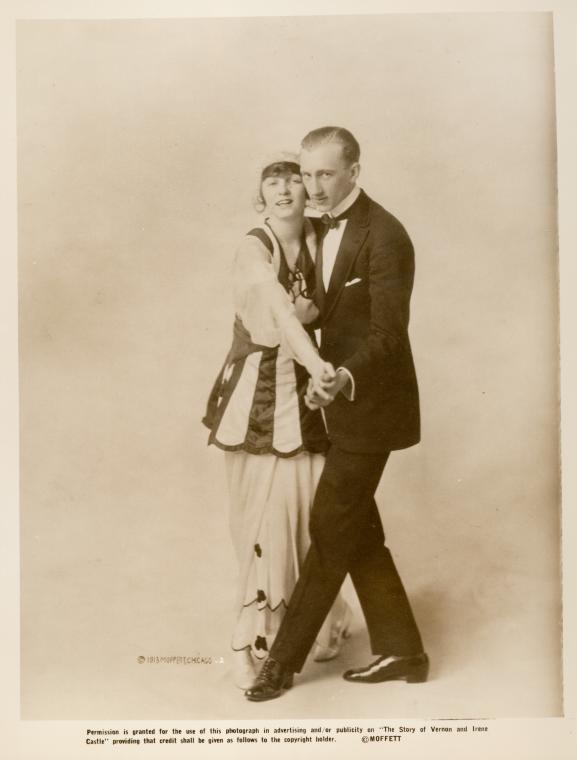Tango Craze
Back to Research > History > Musical Styles and Venues in America
Somewhere between 1912 and 1914 a young couple arrived in New York City from Paris named Vernon and Irene Castle. They fancied themselves professional dancers and brought with them a new dance that had caught on in Europe called the Tango.
Vernon and Irene Castle
The tango was a dance and musical style that originated in the slums of Buenos Aires, Argentina, and Montevideo, Uruguay. The word ‘tango’ was already in use in Andalusia describing a style of local music. It appears that the word was co-opted for the emerging Argentine trend.
The term Tango seems to have first been used in Argentina in connection with the dance in the 1890s. By 1902 the Teatro Opera had started including the tango in their balls. Initially tango was just one of the many available local dances, but it soon became popular throughout society. Theaters and street barrel organs spread it from the slums to the suburbs. Influences that contributed to the development of the tango came from multiple European and Indian ethnicities. For this reason Tango is often referred to as the music of the Argentine immigrants.
During the period 1903 – 1910 over a third of the 1,000 gramophone records released in America were tango music. Tango sheet music was also popular. In 1910 the bandoneon was introduced to Buenos Aires from Germany and it become linked inextricably with tango music. By 1912, Juan “Pacho” Maglio was very popular with his recorded tangos featuring the bandoneon accompanied by flute, violin and guitar. Between 1910 and 1920 tango was featured on 2,500 of the 5,500 records released.
It was in this setting that Vernon and Irene Castle arrived with their dance demonstrations. The music was already familiar – now there was an exciting physical demonstration of movement. It was exotic and sensuous. It caught on like wildfire.
The American Tango craze took over the dance halls of the nation. The craze initiated Dance Wars and Tango Battles. The more conservative elements of American society were appalled at the sexual innuendo and depravity and sought laws regulating all dancing. In fairness, they believed most of the dances of the day were too suggestive but the tango was viewed as the most depraved. There were even federal laws proposed to have Tango banned altogether. It’s important to note that many years earlier the public had felt the same way about the waltz.
Although Tango had been in America since around 1907, it was relatively unknown until the Castles demonstrated how it should be done. They must have been very good dancers as they were responsible for making many other dances popular. They invented a dance called the ‘Castlewalk’ which brought together many of the more popular dances of the time. The various dances that made up the Castlewalk were thought of as merely ‘steps.’ So the idea of a dance being many steps became a popular notion. This idea led in time to the Ballroom dances of today. It is interesting to note that one of the Castlewalk steps was called the Fox Trot. Eventually the Fox Trot became a separate dance. Tango continued to evolve (the Castles helped here) and eventually developed into the modern Ballroom Tango of today.
As the dance became more popular it gained credibility with middle and upper classes around the world. Argentine high society adopted the previously low-class dance form as their own. In 1913 tango began to move from the slums to elegant dance palaces. In 1916, Roberto Firpo, a successful bandleader of the period, revised the arrangements for sextet: two bandoneons, two violins, piano and double bass. Firpo heard a march by Uruguayan Gerardo Mattos Rodriguez and adapted it for tango, creating the popular and iconic La Cumparsita. In 1917 folk singer Carlos Gardel recorded his first tango song‘Mi Noche Triste’, forever associating tango with the feeling of tragic love.
Violinist Julio De Caro formed an orchestra of classically trained musicians in 1920 and recreated the tango as more elegant, complex and refined (and slowed the tempo). With Pedro Laurenz on bandoneon, De Caro’s orchestra was famous for over a decade.
In Argentina, the onset in 1929 of the Great Depression, and restrictions introduced after the overthrow of the Hipólito Yrigoyen government in 1930 caused Tango to decline. Its fortunes were reversed, as tango again became widely fashionable and a matter of national pride under the government of dictator Juan Perón. Tango declined again in the 1950s with economic depression and as the military dictatorships banned public gatherings, followed by the popularity of Rock and Roll. The dance lived on in smaller venues until its revival in the 1980s following the opening in Paris of the show Tango Argentina and the Broadway musical Forever Tango.
If you would like to use content from this page, see our Terms of Usage policy.© 2008, Leonard Wyeth




